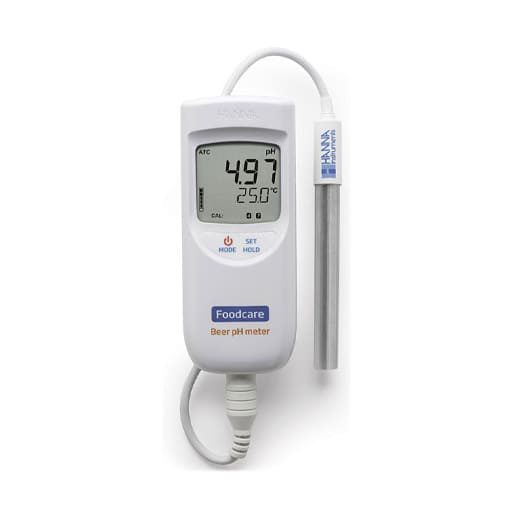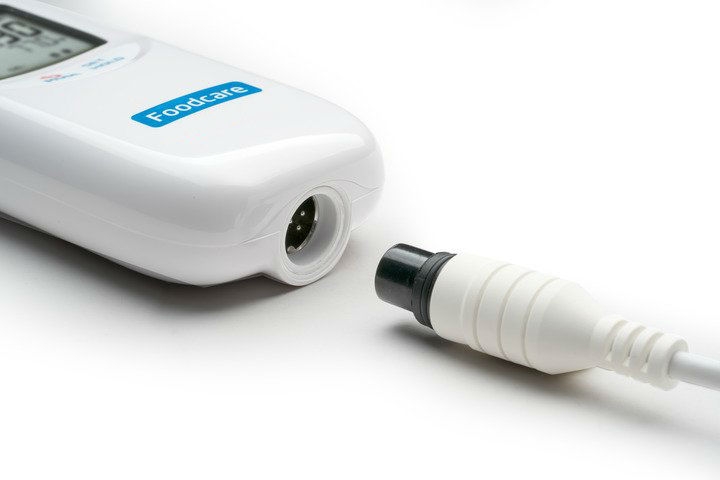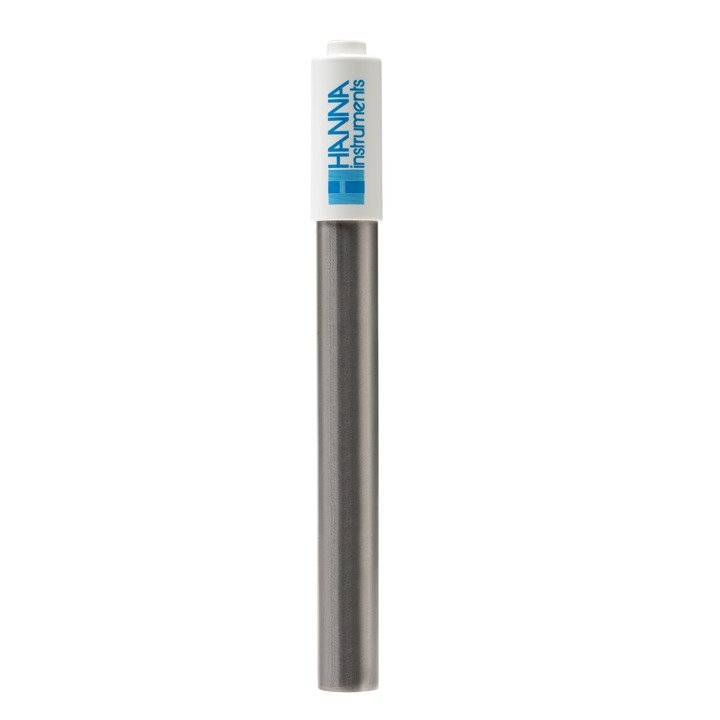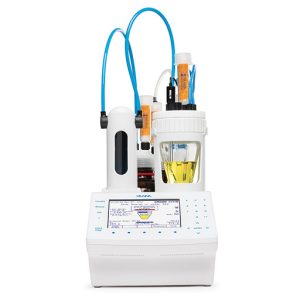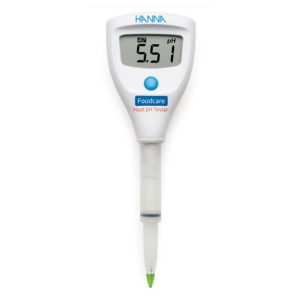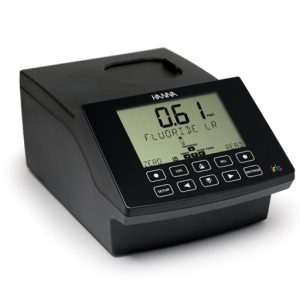The Hanna HI99151 pH is a robust, waterproof pocket-sized pH / temperature meter. The specialized FC214D amplified pH electrode offers numerous features that improve pH testing in beer.
Great for professionals and home brewers!
- Waterproof design for safe operation
- Titanium pH electrode for increased durability
- Built-in Temperature Sensor eliminates errors with Automatic Temperature Compensation
- Withstands the knocks, drops, and spills of real life, IP67 body.
- Fits in your hand for field testing
- Multilevel LCD display shows pH and temperature
- A Quick Connect DIN connector makes attaching easy.
- A temperature sensor is integrated to perform temperature-compensated pH measurements so no separate probe is needed.
Cloth Junction
Our pH electrode has a junction made of renewable cloth material that can be pulled out to expose a new, renewed portion when the readings get erratic or unstable. This cloth material can be easily clogged by samples such as mash, which has a high solids content, or wort, which is viscous. With the cloth junction of the FC214D, it is possible to clear any obstruction by simply extracting 1/8” of the junction from the electrode.

Specifications
| SKU | HI99151 |
| Name | Beer Analysis pH Portable Meter – HI99151 |
| pH Range | -2.00 to 16.00 pH; -2.0 to 16.0 pH |
| pH Resolution | 0.01 pH; 0.1 pH |
| pH Accuracy | ±0.02 pH; ±0.1 pH |
| pH Calibration | automatic, at one or two points with two sets of buffers (standard 4.01, 7.01,10.01 or NIST 4.01, 6.86, 9.18) |
| pH Temperature Compensation | automatic ‐5.0 to 105.0 °C/23.0 to 221.0 °F |
| pH CAL Check (electrode diagnostics) | probe condition indicator |
| mV Range | ±825 mV (pH‐mV) |
| mV Resolution | 1 mV (pH‐mV) |
| mV Accuracy | ±1 mV (pH‐mV) |
| Temperature Range | -5.0 to 105.0°C / 23.0 to 221.0°F |
| Temperature Resolution | 0.1°C / 0.1°F |
| Temperature Accuracy | ±0.5°C (up to 60°C); ±1.0°C (outside) / ±1°F (up to 140°F); ±2.0°F (outside) |
| pH Electrode | FC2143 pre-amplified pH probe with internal temperature sensor, quick connect DIN connector and 1 m (3.3’) cable (included) |
| Automatic Shut-Off | user selectable: after 8 min, 60 min or disabled |
| Battery Type/Life | 1.5V (3) AAA / approximately 1200 hours of continuous use |
| IP Protection | IP67 |
| Environment | -5 to 50°C (23 to 122°F); RH max 100% |
| Dimensions | 154 x 63 x 30 mm (6.1 x 2.5 x 1.2”) |
| Weight | 196 g (6.91 oz.) |
The brewing process
In the brewing process, the enzymes required to convert the starch into sugar are pH-sensitive with an optimal pH range between 5.2 pH and 5.6 pH. Different compounds are used to adjust the pH including phosphoric acid, lactic acid, and gypsum. Wort clarity and break formation are also affected by pH. Protein coagulation occurs during wort boiling, where the optimum pH is around 4.9, even though a common boil pH is 5.2. A pH that is too high will not only inhibit coagulation but also promote browning due to the interaction of amino acids and reducing sugars.
Hop utilization during the wort boil is also affected by pH. As pH increases, the solubility of hop resins increases. Unfortunately for hop lovers, a high pH also increases the release of tannins resulting in a harsher taste. Higher pH also favors elevated microbial activity.
As a living catalyst, yeast maintains a pH of around 6.5 within its cells; however, the preference is to inhabit a more acidic environment. During the fermentation stage, the pH should be lower to accommodate the yeast and also to ensure microbial stability and consistent flavoring of the beer; an optimal pH range during fermentation is between pH 4.1 and 4.3.

QUICK TIP:
How to do a basic pH measurement
Make sure the meter has been calibrated before use. If the probe is dry, soak it in HI70300 storage solution for 30 minutes to reactivate it.
If soiled, clean the electrode by soaking in the cleaning solution for 20 minutes, then rinse the tip and soak in storage solution at least 30 minutes before use.
Rinse the electrode off well and shake off excess droplets.
Recalibrate before using.
Submerge the probe in the sample to be tested while stirring it gently. Wait until the tag on the LCD disappears.
The LCD displays the pH value (automatically compensated for temperature) on the primary LCD, while the secondary LCD displays the sample temperature.
If measurements are taken in different samples successively, rinse the probe tip thoroughly in distilled or deionized water to eliminate cross-contamination.
For better accuracy, frequent calibration of the pH sensor with the meter is recommended.
In addition, the meter must be recalibrated:
a) whenever the pH electrode is replaced.
b) after testing aggressive chemicals.
c) when high accuracy is required.
d) at least once a month.
e) after cleaning the sensor.
The Hanna HI99151 pH is a robust, waterproof pocket-sized pH / temperature meter. The specialized FC214D amplified pH electrode offers numerous features that improve pH testing in beer.
Great for professionals and home brewers!
- Waterproof design for safe operation
- Titanium pH electrode for increased durability
- Built-in Temperature Sensor eliminates errors with Automatic Temperature Compensation
- Withstands the knocks, drops, and spills of real life, IP67 body.
- Fits in your hand for field testing
- Multilevel LCD display shows pH and temperature
- A Quick Connect DIN connector makes attaching easy.
- A temperature sensor is integrated to perform temperature-compensated pH measurements so no separate probe is needed.
Cloth Junction
Our pH electrode has a junction made of renewable cloth material that can be pulled out to expose a new, renewed portion when the readings get erratic or unstable. This cloth material can be easily clogged by samples such as mash, which has a high solids content, or wort, which is viscous. With the cloth junction of the FC214D, it is possible to clear any obstruction by simply extracting 1/8” of the junction from the electrode.

Specifications
| SKU | HI99151 |
| Name | Beer Analysis pH Portable Meter – HI99151 |
| pH Range | -2.00 to 16.00 pH; -2.0 to 16.0 pH |
| pH Resolution | 0.01 pH; 0.1 pH |
| pH Accuracy | ±0.02 pH; ±0.1 pH |
| pH Calibration | automatic, at one or two points with two sets of buffers (standard 4.01, 7.01,10.01 or NIST 4.01, 6.86, 9.18) |
| pH Temperature Compensation | automatic ‐5.0 to 105.0 °C/23.0 to 221.0 °F |
| pH CAL Check (electrode diagnostics) | probe condition indicator |
| mV Range | ±825 mV (pH‐mV) |
| mV Resolution | 1 mV (pH‐mV) |
| mV Accuracy | ±1 mV (pH‐mV) |
| Temperature Range | -5.0 to 105.0°C / 23.0 to 221.0°F |
| Temperature Resolution | 0.1°C / 0.1°F |
| Temperature Accuracy | ±0.5°C (up to 60°C); ±1.0°C (outside) / ±1°F (up to 140°F); ±2.0°F (outside) |
| pH Electrode | FC2143 pre-amplified pH probe with internal temperature sensor, quick connect DIN connector and 1 m (3.3’) cable (included) |
| Automatic Shut-Off | user selectable: after 8 min, 60 min or disabled |
| Battery Type/Life | 1.5V (3) AAA / approximately 1200 hours of continuous use |
| IP Protection | IP67 |
| Environment | -5 to 50°C (23 to 122°F); RH max 100% |
| Dimensions | 154 x 63 x 30 mm (6.1 x 2.5 x 1.2”) |
| Weight | 196 g (6.91 oz.) |
The brewing process
In the brewing process, the enzymes required to convert the starch into sugar are pH-sensitive with an optimal pH range between 5.2 pH and 5.6 pH. Different compounds are used to adjust the pH including phosphoric acid, lactic acid, and gypsum. Wort clarity and break formation are also affected by pH. Protein coagulation occurs during wort boiling, where the optimum pH is around 4.9, even though a common boil pH is 5.2. A pH that is too high will not only inhibit coagulation but also promote browning due to the interaction of amino acids and reducing sugars.
Hop utilization during the wort boil is also affected by pH. As pH increases, the solubility of hop resins increases. Unfortunately for hop lovers, a high pH also increases the release of tannins resulting in a harsher taste. Higher pH also favors elevated microbial activity.
As a living catalyst, yeast maintains a pH of around 6.5 within its cells; however, the preference is to inhabit a more acidic environment. During the fermentation stage, the pH should be lower to accommodate the yeast and also to ensure microbial stability and consistent flavoring of the beer; an optimal pH range during fermentation is between pH 4.1 and 4.3.

QUICK TIP:
How to do a basic pH measurement
Make sure the meter has been calibrated before use. If the probe is dry, soak it in HI70300 storage solution for 30 minutes to reactivate it.
If soiled, clean the electrode by soaking in the cleaning solution for 20 minutes, then rinse the tip and soak in storage solution at least 30 minutes before use.
Rinse the electrode off well and shake off excess droplets.
Recalibrate before using.
Submerge the probe in the sample to be tested while stirring it gently. Wait until the tag on the LCD disappears.
The LCD displays the pH value (automatically compensated for temperature) on the primary LCD, while the secondary LCD displays the sample temperature.
If measurements are taken in different samples successively, rinse the probe tip thoroughly in distilled or deionized water to eliminate cross-contamination.
For better accuracy, frequent calibration of the pH sensor with the meter is recommended.
In addition, the meter must be recalibrated:
a) whenever the pH electrode is replaced.
b) after testing aggressive chemicals.
c) when high accuracy is required.
d) at least once a month.
e) after cleaning the sensor.






